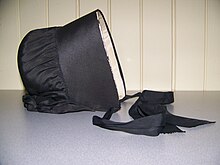This article includes a list of general references, but it lacks sufficient corresponding inline citations. (May 2015) |
| Part of a series on the |
| Quakers in Canada |
|---|
 |
| Timeline |
| Meetings |
|
The Children of Peace (1812–1889) was an Upper Canadian Quaker sect under the leadership of David Willson, known also as 'Davidites', who separated during the War of 1812 from the Yonge Street Monthly Meeting in what is now Newmarket, Ontario, and moved to the Willsons' farm. Their last service was held in the Sharon Temple in 1889.
Between 1825 and 1832, a series of buildings was constructed on the farm, the most notable of which is the Sharon Temple, an architectural symbol of their vision of a society based on the values of peace, equality and social justice, which is now part of an open-air museum that was in 1990 designated as National Historic Site of Canada.
They were a "plain folk", former Quakers with no musical tradition, who went on to create the first silver band in Canada and build the first organ in Ontario.[1] They built an ornate temple to raise money for the poor, and built the province's first shelter for the homeless.[2] By 1851, Sharon Temple was the most prosperous agricultural settlement in the province. They took a lead role in the organization of the province's first co-operative, the Farmers' Storehouse, and opened the province's first credit union.[3] Through their support of William Lyon Mackenzie, and by ensuring the elections of both "fathers of responsible government", Robert Baldwin and Louis LaFontaine, they played a critical role in the development of democracy in Canada.[4]
- ^ Schrauwers, Albert (1993). Awaiting the Millennium: The Children of Peace and the Village of Hope 1812-1889. Toronto: University of Toronto Press. pp. 71–72.
- ^ Sharon Temple, On-line Exhibition
- ^ Schrauwers, Albert (2009). 'Union is Strength': W.L. Mackenzie, The Children of Peace and the Emergence of Joint Stock Democracy in Upper Canada. Toronto: University of Toronto Press. pp. 97–124.
- ^ Schrauwers, Albert (2009). 'Union is Strength': W.L. Mackenzie, The Children of Peace and the Emergence of Joint Stock Democracy in Upper Canada. Toronto: University of Toronto Press. pp. 125–149, 211–243.